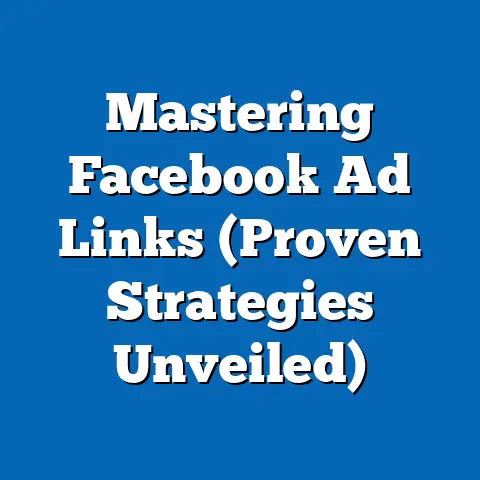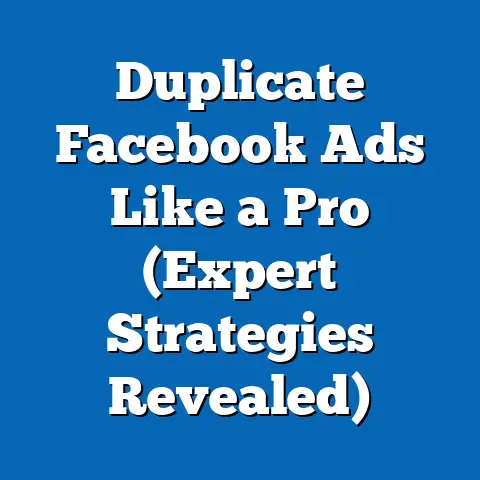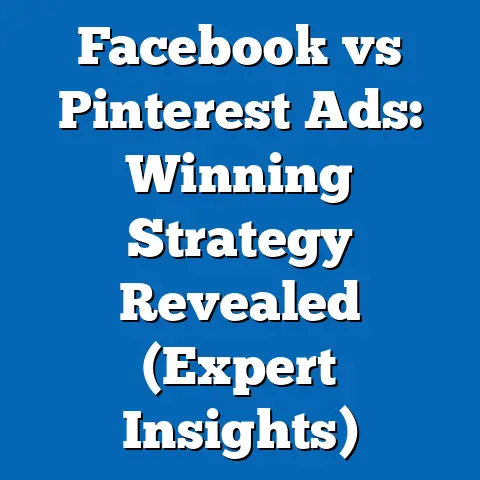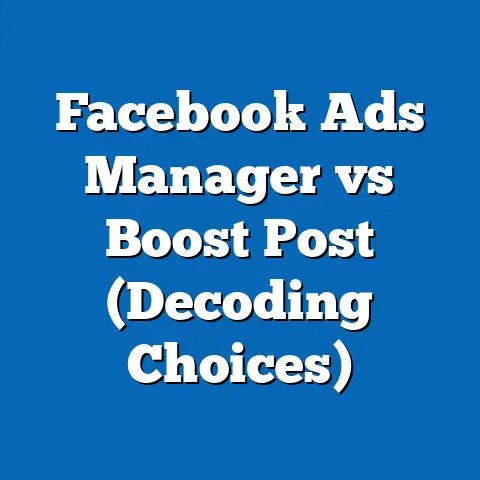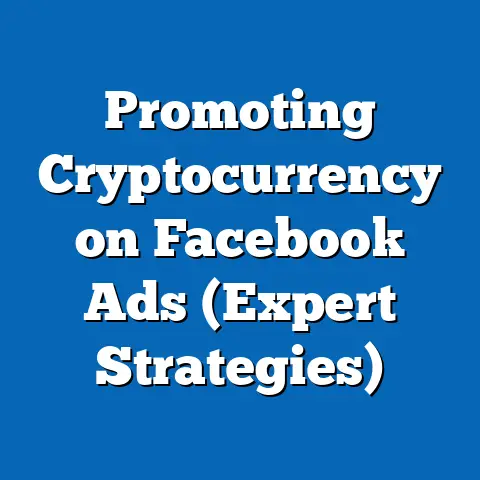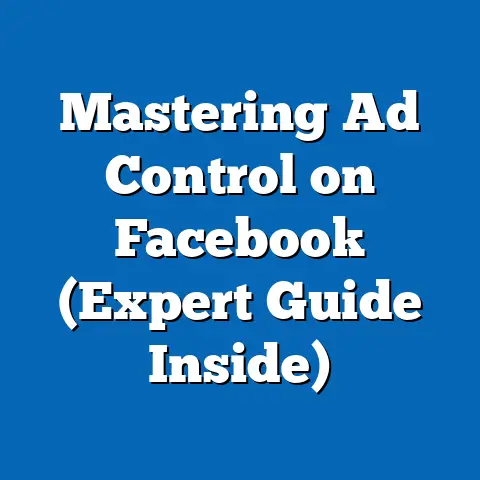Facebook Advertising vs Boost Post (Unlock Profitable Strategies)
In the vast digital savanna of social media marketing, two distinct tribes roam the landscape of Facebook: the meticulous strategists of Facebook Advertising and the quick-strike opportunists of Boost Post. Much like political factions, these groups exhibit unique demographic makeups, core beliefs about how to achieve marketing success, and distinct “voting patterns” in terms of budget allocation and engagement metrics. While one group meticulously crafts targeted campaigns with surgical precision, the other thrives on spontaneity, boosting content with the click of a button—yet both claim the mantle of profitability in the ever-evolving battle for audience attention.
This article will delve into a comprehensive, data-driven analysis of these two approaches to Facebook marketing. We’ll explore their demographic compositions (in terms of user types and business profiles), core philosophies, “voting patterns” (engagement and conversion metrics), policy positions (strategic priorities), and distinguishing features. By grounding our analysis in empirical data, including advertising spend statistics and performance metrics, we aim to unlock the profitable strategies that define each approach while placing their rivalry in the broader context of digital marketing trends.
Defining the Tribes: Demographic Composition
Facebook Advertising Users
The tribe of Facebook Advertising users primarily consists of medium to large businesses, marketing agencies, and professional digital marketers, often with dedicated budgets and specialized teams. According to a 2022 report by Statista, businesses with annual revenues exceeding $1 million are 65% more likely to use full-scale Facebook Ads Manager for campaigns compared to smaller enterprises. Demographically, these users skew toward individuals aged 25-44, with higher levels of education (often holding marketing or business degrees), and are predominantly urban-based, reflecting access to tech hubs and larger markets.
Boost Post Enthusiasts
In contrast, the Boost Post tribe is largely composed of small business owners, solopreneurs, and casual social media users who manage their own pages with limited budgets. Data from a 2021 Facebook Small Business Report indicates that 58% of small businesses with fewer than 10 employees use Boost Post as their primary advertising tool, compared to only 12% utilizing full-scale ad campaigns. These users tend to be more diverse in age (spanning 18-54), often lack formal marketing training, and are more likely to operate in local markets or niche industries like retail, hospitality, and personal services.
Geographically, Boost Post users are often found in suburban and rural areas, where digital marketing resources may be less accessible. A 2022 study by Social Media Examiner found that 63% of Boost Post users cite “ease of use” as their primary reason for choosing this method, reflecting a demographic that values simplicity over complexity. This mirrors a political faction that prioritizes accessibility and immediate impact over long-term strategy.
Comparative Analysis
While both groups aim to maximize reach on Facebook, their demographic compositions reveal a divide akin to urban technocrats versus grassroots populists. Facebook Advertising users are the “elite planners,” equipped with resources and expertise, while Boost Post enthusiasts represent the “everyman marketer,” relying on instinct and immediacy. This divide shapes their core beliefs and strategic approaches, as we’ll explore next.
Core Beliefs and Values
Facebook Advertising: Precision and Scalability
At the heart of the Facebook Advertising tribe lies a belief in precision targeting and scalability as the keys to profitability. These users value the platform’s robust tools, such as Custom Audiences and Lookalike Audiences, which allow them to reach hyper-specific demographics. A 2023 report by eMarketer found that 78% of advertisers using Ads Manager prioritize data analytics to optimize campaigns, reflecting a core belief in measurable outcomes over guesswork.
This group also values long-term investment, often allocating significant budgets to test and refine campaigns. According to Facebook’s own 2022 Advertising Insights, businesses using Ads Manager spend an average of $3,500 per month, compared to just $150 for Boost Post users. Their philosophy aligns with a political ideology that emphasizes infrastructure and systemic planning over quick fixes.
Boost Post: Speed and Accessibility
Conversely, Boost Post enthusiasts champion speed and accessibility as their guiding principles. They believe that immediate visibility, even if less targeted, can yield results for small-scale operations with limited time and resources. A 2021 survey by Buffer revealed that 67% of Boost Post users value the ability to promote content directly from their page without navigating complex ad tools, underscoring a belief in democratized marketing.
This group often operates on a “post and pray” mentality, prioritizing organic content amplification over detailed strategy. Their average ad spend, as noted earlier, is significantly lower, reflecting a philosophy akin to a political movement that seeks quick, tangible wins for the masses rather than intricate, long-term policies.
Consensus and Division
Both tribes share a consensus on the importance of Facebook as a marketing platform—data from Statista (2023) shows that 93% of businesses, regardless of size, use Facebook for promotion. However, divisions emerge in their approach to resource allocation and trust in data versus intuition. These differing values manifest in their “voting patterns,” or how they engage with and measure success on the platform.
Voting Patterns and Political Engagement (Metrics and Performance)
Facebook Advertising: High Engagement Through Targeting
Moreover, these users exhibit higher “political engagement” in terms of budget commitment and campaign duration. Data from Facebook’s Ad Library (2023) indicates that Ads Manager campaigns often run for 30-60 days, allowing for A/B testing and optimization, with an average cost-per-conversion of $18. This mirrors a political coalition that invests heavily in long-term voter turnout strategies.
Boost Post: Quick Reach, Limited Depth
Boost Post users, by contrast, prioritize reach over depth, often achieving broader but less engaged audiences. The same WordStream study noted that while Boosted Posts garner an average reach of 10,000 impressions per $100 spent, their conversion rates lag at 0.5%, half that of full-scale ad campaigns. This reflects a “voting pattern” of short-term visibility over sustained engagement.
Their engagement is also more sporadic, with campaigns typically lasting 3-7 days. A 2021 report by Socialbakers found that 54% of Boost Post users measure success by likes and shares rather than conversions, akin to a political group focusing on rally attendance rather than policy impact. This pattern underscores their preference for immediate, visible results.
Comparative Metrics
When comparing the two, Facebook Advertising clearly outperforms in conversion metrics and engagement quality, while Boost Post excels in rapid reach for minimal investment. For instance, a $500 campaign via Ads Manager might yield 300 clicks and 15 conversions, whereas the same budget on Boost Post could generate 50,000 impressions but only 5 conversions (WordStream, 2022). This divide mirrors political campaigns where one faction prioritizes deep voter loyalty while the other seeks broad name recognition.
Policy Positions on Major Issues (Strategic Priorities)
Facebook Advertising: Data-Driven Optimization
On the “policy” front, Facebook Advertising users advocate for data-driven optimization as their primary issue. Their strategic priorities include audience segmentation, retargeting, and funnel-based campaigns (awareness to conversion). A 2023 report by HubSpot found that 82% of Ads Manager users allocate budget to retargeting ads, which boast a 70% higher conversion rate than initial ads.
They also prioritize multi-platform integration, often linking Facebook campaigns with Instagram and Messenger ads. This “policy platform” reflects a belief in comprehensive, interconnected strategies, much like a political party pushing for systemic reform across multiple sectors.
Boost Post: Organic Content Amplification
Boost Post enthusiasts, meanwhile, focus on amplifying organic content as their core “policy issue.” Their strategy hinges on promoting existing posts to local or interest-based audiences with minimal customization. According to a 2022 study by Sprout Social, 61% of Boost Post users target broad demographics (e.g., “people near my business”) rather than niche segments, reflecting a simpler, less resource-intensive approach.
Their secondary priority is cost control, often limiting spends to under $50 per post. This mirrors a political stance of fiscal conservatism, emphasizing low-risk, high-visibility tactics over expansive, costly campaigns.
Areas of Consensus and Division
Both groups agree on the importance of visual content—data from Facebook (2023) shows that posts with images or videos achieve 2.3x more engagement across both methods. However, they diverge sharply on targeting depth and budget scale, with Ads Manager users willing to invest in analytics tools (e.g., Pixel tracking) while Boost Post users lean on platform defaults. These differences shape their distinguishing features, as explored below.
Distinguishing Features from Other Groups
Facebook Advertising: Complexity and Customization
What sets Facebook Advertising apart is its complexity and customization, distinguishing it not only from Boost Post but also from other platforms like Google Ads. Users can create dynamic ads, carousel formats, and lead generation forms, tailoring campaigns to specific objectives. A 2022 report by AdEspresso noted that Ads Manager offers over 15 ad formats compared to Boost Post’s singular format, providing a versatility akin to a political party with a detailed, multi-faceted platform.
This group also stands out for its reliance on third-party tools (e.g., Canva for creatives, Zapier for automation), reflecting a tech-savvy, professional identity. Unlike Boost Post users, their campaigns are rarely impulsive, often following a 90-day planning cycle (Hootsuite, 2023).
Boost Post: Simplicity and Spontaneity
Boost Post’s defining feature is its simplicity, setting it apart as the “plug-and-play” option for Facebook marketing. Unlike Ads Manager, it requires no learning curve—users can boost a post in under 5 minutes with a predefined audience. A 2021 survey by Social Media Today found that 74% of Boost Post users have never used Ads Manager, highlighting their distinct preference for straightforward tools.
This spontaneity also differentiates them from other low-budget marketing methods, such as organic posting or email campaigns, as Boost Post offers a paid shortcut to visibility. Their approach mirrors a political faction that thrives on grassroots momentum rather than structured organization.
Intersections with Demographic Factors
Age and Education
Age and education play significant roles in shaping preferences for each method. Younger marketers (18-34) and those with college degrees are 60% more likely to use Ads Manager, reflecting familiarity with digital tools and analytics (Statista, 2022). Older users (45+) and those without formal training often gravitate toward Boost Post, valuing its user-friendly interface.
Industry and Revenue
Industry type and revenue levels further influence adoption. E-commerce businesses with revenues over $500,000 annually dominate Ads Manager usage (68% adoption rate), while local service providers with under $100,000 in revenue prefer Boost Post (72% adoption rate), per a 2023 Shopify report. This divide mirrors political coalitions split by economic class and access to resources.
Geographic and Cultural Factors
Geographic location also intersects with usage patterns. Urban businesses in tech-forward regions like North America and Western Europe account for 75% of Ads Manager spend, while rural and developing markets lean toward Boost Post (Facebook Small Business Report, 2021). Culturally, regions with a DIY ethos (e.g., small-town USA) favor Boost Post’s accessibility over the perceived complexity of full-scale ads.
Historical and Social Context
The rivalry between Facebook Advertising and Boost Post must be understood within the broader evolution of social media marketing. When Facebook introduced paid advertising in 2007, it catered primarily to large brands with complex campaigns, laying the groundwork for today’s Ads Manager. Boost Post, launched in 2012, emerged as a response to the democratization of digital marketing, aiming to empower small businesses amid growing competition for organic reach.
Socially, this divide reflects broader trends in technology adoption and economic inequality. Larger firms with access to capital and talent have embraced data-driven advertising, while smaller players, often constrained by time and budget, rely on simplified tools. This mirrors historical political divides between institutional power and populist movements, with each group leveraging Facebook’s ecosystem to carve out influence.
Patterns and Trends: Which Strategy Wins?
Performance Trends
Empirical data suggests that Facebook Advertising generally outperforms Boost Post in profitability for businesses with budgets over $500 monthly. A 2023 analysis by Marketing Land found that Ads Manager campaigns yield a 3.5x higher ROI for e-commerce compared to Boost Post. However, for micro-businesses spending under $100, Boost Post often delivers comparable reach at a lower cost-per-impression ($0.01 vs. $0.03 for Ads Manager).
Emerging Shifts
Trends also indicate a growing hybrid approach, with 45% of small businesses experimenting with both methods in 2022 (Social Media Examiner). As Facebook continues to refine its algorithm and ad tools, the line between these tribes may blur, much like political coalitions that adapt to shifting voter priorities.
Long-Term Implications
Over the long term, the scalability of Facebook Advertising positions it as the dominant strategy for growth-oriented businesses. However, Boost Post retains relevance for hyper-local marketing and rapid brand awareness, particularly in underserved markets. This duality suggests that profitability lies in strategic alignment with business size, goals, and audience type.
Conclusion: Unlocking Profitable Strategies
In the digital marketing arena, the tribes of Facebook Advertising and Boost Post represent two distinct philosophies—precision versus simplicity, investment versus immediacy. Backed by demographic data and performance metrics, our analysis reveals that while Ads Manager excels in conversion and engagement for larger budgets (CTR of 1.2%, ROI of 3.5x), Boost Post offers unmatched reach for minimal spend (10,000 impressions per $100). Their differences mirror political divides between systemic planners and grassroots activists, yet both hold value depending on context.
Ultimately, unlocking profitable strategies requires understanding one’s “demographic” as a marketer—business size, industry, and goals—much like tailoring a political campaign to a specific electorate. For larger enterprises, Facebook Advertising’s data-driven approach is the clear path to scalability, while small businesses can leverage Boost Post for quick, cost-effective visibility. As the digital landscape evolves, a hybrid strategy may emerge as the ultimate consensus, blending the strengths of both tribes to maximize impact in an increasingly competitive space.

